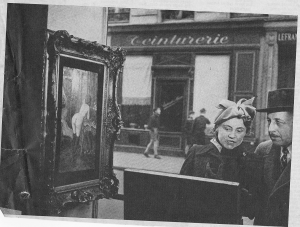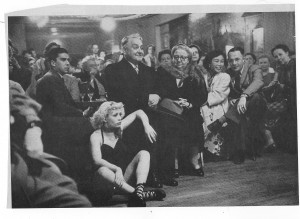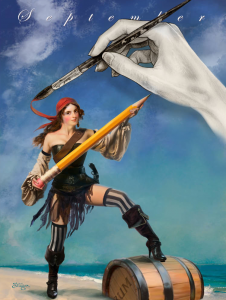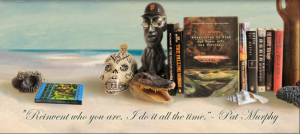In my experience, collaborations are always experiments in creativity. A few months ago, the folks at Clarion asked me to participate in engage in a collaboration that I thought was extremely interesting. They asked if I would work with pinup (and SF cover) artist Lee Moyer to create an image for Clarion’s Literary Pin-up Calendar.
I responded with enthusiasm — and with what some might have considered a warning. My response: “Given my association with the Tiptree Award and my commitment to expanding gender roles, I know you realize I will be working to expand, explore, and subvert the concept of pin-up — while participating in the creation of a pin-up. Since the pinup itself is a subversive form, subversion and testing of boundaries is a natural part of the process. Or so it seems to me.”
Lee Moyer was definitely up for the challenge. He replied: “I want my pin-ups to be creative (and sometimes even subversive), and to represent a wide variety of humanity (even if they’ve 6 arms and stripes, or are robots, humanoid aliens, et al)…. Pin-ups can challenge the viewer in unexpected ways. I like to include visual touches that might surprise and delight when they are discovered. ”
And so Lee and I began a very interesting collaborative project. I figured I’d do a blog post about it both to publicize the calendar (now available through Clarion’s Indigogo campaign here) and to provide a window into the process of creating the pin-up that Lee created for my work.
First, full disclosure — just so you know where I’m coming from.
I count myself as a feminist. Back in 1991, with Karen Fowler, I founded the James Tiptree Jr. Award, which supports speculative fiction that explores and expands gender roles. Just a few years after founding the Tiptree Award, I took a porn writing class from Pat Califia. (For those who don’t know, Pat Califia wrote an amazing collection of BDSM erotica titled Macho Sluts.) Inspired by that class, I wrote and published women’s erotica. Oh, yeah — and I’ve posed naked. (Hardly a pin-up — the photo was incorporated into a collage by the wonderful collage artist Freddie Baer.) In the labels that were used back in the day, I might have been called a sex-positive feminist, in the same camp as Susie Bright.
Sexuality and feminism can be a tricky combination. And creating a pin-up — a playful presentation of sexuality — is particularly tricky. After all, one person’s playful picture is another’s image of exploitation. Pin-ups can be regarded as images designed for the male gaze, objectifying women for the benefit of horny guys. But pin-ups can also be a channel for feminist empowerment — women taking control of their own sexuality. For me, feminist pin-ups fit quite comfortably in the same category as San Francisco’s Good Vibrations, the first adult store to provide a woman-friendly shopping environment for sex toys.
Since the juxtaposition of feminism and sexuality can be tricky, I thought long and hard about what makes a pin-up empowering — and what makes it exploitative. For me, the key difference is intentionality. For an image to be empowering, the person who is the pinup must be in charge of the situation. She/he is aware of who is watching and who she/he wants to be watching.
For me, what’s most relevant is not who is pictured: male or female, fat or thin, pale and blonde or dark and brunette. What matters is who is in control of the situation? Who has the power? Who is deciding what the viewer sees? And who is the viewer?
But how can a single image convey an awareness that the woman is in control of her sexuality, that she has the power. How can that same image have a sense of humor about all this — since the best pin-ups don’t take themselves too seriously?
Since I was working with a visual artist, I spent some time looking for images that related to empowerment, control, and who is looking at whom. I sent Lee five images. The first three were photos that I had torn out of magazines at least 30 years ago. I found them interesting because of the stories they tell. None are quite the visual story I wanted to tell with a pin-up, but they hint at how that story might be told. [A side note here: If anyone out there can help me find the photographers/sources of these photos, I’d appreciate it. I hate posting the images without obtaining permission, but I needed the images to tell this story.]

This first image is about the male gaze; the woman is unaware of the man’s focus. Imagine this picture with the roles reversed — the woman is looking at the nude portrait with interest; the man is oblivious. That would be more interesting, I think.

The second image comes closer to a power dynamic that intrigues me. This one definitely has the sense of a hidden story. The older woman is watching the younger one — rather interested, I think. Not sexual interest, but a little bit of amusement, maybe remembering when she was that age. This image is, for me, about the women. The guy is there, but it’s not really his story.
![The third image (and the poorest scan, I’m sorry to say] is my favorite. The man is creating his own reality. The woman who is posing is amused. I’m amused along with the woman.](http://www.brazenhussies.net/murphy/wp-content/uploads/2013/11/WhoIsLooking3-painter2-fromGrab-231x300.jpg)
The third image (and the poorest scan, I’m sorry to say) is my favorite. The man is creating his own reality. The woman who is posing is amused. I’m amused along with the woman.
And here are two images I can link to. First, the wonderful image of photographer Imogene Cunningham and artist’s model Twinka Thiebaud, taken by Judy Dater in 1974. I believe this photo combines pin-up characteristics with feminist empowerment. Cunningham was noted, among other things, for her depiction of the male nude (photos of her husband), which shocked Seattle in 1915. Twinka is very much in possession of her own sexuality and comfortable in her own skin. And Imogene matches her in confidence, regarding her with interest and a touch of amusement. The look between Twinka and Imogen Cunningham is as good as a whole conversation.
Finally, here’s an image of a noted woman pin-up painter, Zoe Mozert, pictured painting a pin-up style image of Jane Russell as part of the publicity for The Outlaw (1945). Two women are working together to create an image of one very hot, very dangerous woman.
So where does all this take me, as far as the creation of a pin-up related to my own work. It takes me directly to my novel, Adventures in Time and Space with Max Merriwell, the final novel in a metafictional set of books linked by the pseudonyms who wrote them.
Max Merriwell is a pseudonym of mine. He wrote a novel called There and Back Again, which is both a classic space opera and a feminist parody of The Hobbit.
Mary Maxwell is a pseudonym of Max Merriwell’s. She wrote a novel called Wild Angel, which is a feminist reimagining of Tarzan.
And I wrote Adventures in Time and Space with Max Merriwell about Max Merriwell. Max teaches a writing workshop on a cruise ship that sails into the Bermuda Triangle. Events of novels that Max has written bleed through into the reality of the cruise ship, and Max’s pseudonyms show up and start making trouble. And Pat Murphy is a character in all three books.
In Adventures in Time and Space with Max Merriwell, Max describes Mary as “totally fearless.” He says she likes to stir up trouble just for fun. She thinks a little confusion is a wonderful thing, and she’s the inventor of a drink called the Flaming Rum Monkey. I figured Mary would be delighted to pose for a pin-up. She’s very much in possession of her own sexuality and the notion of being a pin-up would amuse her enormously.
So I suggested that Lee create an image posed like the one of Zoe Mozert painting Jane Russell, with the intensity of gaze of the Imogen Cunningham-Twinka image. Mary is posing, and maybe Max is wielding the paintbrush. Max thinks, of course, that he’s in charge of things. Max is like that. Sweet, but a little deluded. Short, gray-haired and bearded, trying to understand women, but not really on target.
And off to one side, perhaps behind Max, there’s a shadowy woman who is exchanging amused glances with Mary — a shared awareness between the women that this is quite entertaining and more than a little silly. That is, of course, the viewer and me. For me, this image deals with questions of agency, power, and humor in the context of a sexual image.
Lee understood what I was after – but felt quite reasonably that the complexity of the image was a bit much for the time frame and that the resulting image would lack the immediacy and clarity that the best pin-ups have. So he proposed something simpler. He sent along samples of work by K.O. Munson, who created “sketchpad” images that had a sense of being in process, with half-completed sketches behind the fully realized pin-up figure. Lee suggested showing Max’s hands in the act of painting a Munson style sketch of Mary. And maybe Mary — the sketch of her, that is — is trying to pull the paintbrush away from Max.
I liked the idea, but rather than having a man’s hands doing the drawing I suggested that hands doing the drawing are a woman’s — they could be Mary Maxwell’s hands, or they could be mine (younger and with a better manicure, of course).
In Adventures in Time and Space with Max Merriwell, Mary talks about how you invent yourself, you tell your own story — essentially, you create who you are. It’s an act of imagination. So it makes sense that Mary is creating herself as a pin-up — and having a good time doing it, since she has a good time doing pretty much everything she does.
I liked Lee’s notion that Mary was trying to seize the power from Max. But in my version of the universe, Mary already has taken that power. She has grabbed the pencil and made it part of her own world. Maybe it’s serving as the pole for a pirate flag. (Mary is dressed as a pirate, of course. That fits with events of the novel.) Or maybe Mary is wielding the pencil like a martial arts staff. (Nasty pointy things, those pencils. Could be plenty dangerous.)
So I sent Lee some images of women in martial arts wielding staffs. To fit my image, Mary needed to look very confident and in control — regardless of how many clothes she was or was not wearing. I wanted her to be holding that pencil as if she was ready to use it.
In all good collaborations, one idea serves as a springboard for a better idea. Lee responded to my suggestions with an idea that I loved. He suggested that the pin-up version of Mary is drawing the hand that is drawing her with the (giant relative to her) pencil she has captured. We would be borrowing a meme from Escher’s Drawing Hands sketch, a visual depiction of a strange loop.
Endlessly recursive and hopelessly metafictional. And very clear that Mary is just as much in charge as whoever is handling the paintbrush. Perfect.
The final step was to come up with a model for the face of the pin-up. I poked around in history to find a face fit the deep thinking behind the pin-up and landed on Fanny Kemble (aka Frances Anne Kemble Butler), a British actress and writer who lived from 1809 to 1893. A noted abolitionist, she was also the first western woman to wear pantaloons (the precursor of trousers) in public. One scholarly site notes that “In the various roles she performed in her life, on stage and off—abolitionist, author, estranged wife—Kemble remained highly theatrical, appropriating and subverting nineteenth-century prescriptions for women’s lives, ever rewriting the roles to which she was assigned by society and inheritance.” All perfect for Mary Maxwell’s character.
And here’s the final image. I’m happy and I think Mary would be happy, too.
Below the image of Mary, on the calendar page, Lee included a quote from Mary in Adventures in Time and Space with Max Merriwell — “Reinvent who you are. I do it all the time.” Words to live by, I think.
You can support the Clarion Science Fiction and Fantasy Writers’ Workshop and get a copy of the calendar for $25 at their Indiegogo campaign. If you want multiple copies of the calendar (and who wouldn’t?), just donate $25 per calendar and send a note to calendar@theclarionfoundation.org saying that you’d like your perks to be in the form of calendars. And have a very happy 2014!



[…] so many talented authors and I am quite pleased with the result of our collaboration. Pat Murphy wrote a splendid piece about working with me on her […]